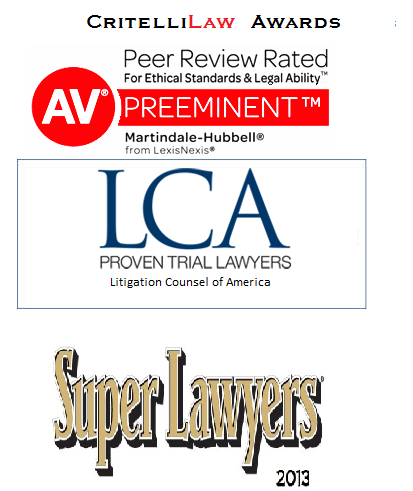Consultants, Referrals and Co-Counsel Relationships
Oct 7th, 2013 | By critellilaw | Category: AlertA Co-Counsel relationship is a lot like this Coast Guard rescue unit. They come together, from different backgrounds, and form a single unit for a particular mission. A legal team is no different. We bring together lawyers from various backgrounds and form a single unit for a particular case.
Recently the Iowa State Bar Association Ethics Committee issued five new opinions relating to professional relationships between lawyers. IA Ethics Opinion 13-05 specifically addressed the Co-Counsel relationship. You may download all five opinions by clicking on this link:
Is this something new, you ask? Now really, it’s been going on for about 750 years in Great Britian where it’s known as the Solicitor-Barrister system. On this side of the Atlantic we view the system as a referral. Live it for a while and you’ll soon learn that it’s anything but that. It is legal teamwork at its best. The Solicitor is the client’s main lawyer; the barrister performs the limited tasks of advising and advocating. It’s a lot like the Coast Guard team in the picture. The coxswain pilots the boat for the other members to do their specility tasks. (No—I’m not in the boat…I the guy back in HQ doing paperwork.)
Unlike the British legal profession with two distinct divisions, solicitor and barrister, the American legal profession is “fused.” In reality, no one lawyer can know all there is to know about the law or possesses skills and talents in all areas of practice. American lawyers are quick to recognize the necessity to “bring in an expert” or to refer a case to a colleague who possesses different talents. Lawyers often seek the help of academics, retired practitioners or practitioners with special knowledge. Unfortunately, rarely are we taught how to refer the case, when to bring in the consultant or how to co-counsel or joint venture a case.
For the purpose of this paper, the lawyer with the client is referred to as the “primary practitioner” and the lawyer to whom the matter is referred or whose aid is sought is called the “secondary practitioner.”
Options for Help
There are three methods of obtaining professional assistance: The Consult, The Referral and the Co-Counsel. In the consultant situation, a lawyer with special knowledge, experience or skill is brought IN to the existing case to assist the primary practitioner. In the referral situation, the case is sent OUT to the accepting lawyer who will handle the matter, usually to the exclusion of the primary practitioner. In a Co-counsel arrangement, the two lawyers join in joint venture to act as a team in representing the client. Each of the three arrangement are different and require different operating structure.
Liability Share or Shift.
The sharing or shifting of one’s professional liability is significant factor in determining which of the three relations will best benefit the client. A consultant and co-counsel relationship involves in a sharing of professional liability whereas a referral usually is manifested in a shift of liability from the primary practitioner to the secondary.
Fees and Costs.
Each of the three relationships involve different financial arrangements. A consultant is usually paid directly by the client for advice or speciality service rendered. In a referral, the lawyer receiving the case will be paid directly by the client . However in a co-counsel or joint venture relationship the fee may be shared. Primary practitioners are cautioned in making a referral. If they with to obtain an interest in the case so as to obtain a fee from a future recovery, they will be deemed to share liability. In this case, liability follows the fee.
Client Consent.
Always remember, the client must consent to all three relationships. This is important because one cannot converse with the potential consultant, referree or potential co-counsel about the case without violating the attorney-client relationship. As with all matters, “informed consent” along with a risk/benefit analysis is mandatory.
Procedure.
I suggest you consider the following procedure when considering adding professional help.
The Referral will usually require three letters and one conference. The process starts with a discussion with the client about the need for a referral. Once the client has given the consent to investigate a referral, a Referral Check letter is sent to the prospective lawyer. The lawyers expertise and skill are confirmed, potential conflict of interests are discussed, the lawyer’s liability insurance status and limits are confirmed. Lastly, the one must determine if the lawyer has the time to devote to the case. If the primary practitioner desires to protect the client for future business, the concept of a non-competition agreement (no poach agreement) should be discussed.
Next a Consent to Refer letter is drawn informing the client of the necessity for the referral, information regarding the potential lawyer, the fact that once the case is referred the primary practitioner’s duties to the client under the existing attorney-client agreement will be discharged and, most importantly, obtaining the consent of the client to make the referral. Once the consent has been obtained, the last documentation is the Referral Letter to the accepting lawyer. A summary of the case is given, all documents are transmitted and appropriate deadlines are discussed and the referring lawyer’s discharge from duties and responsibility are confirmed. Lastly, I strongly suggest that the primary practitioner accompany the client to the first conference with the new lawyer.
The process used to bring in a consultant is similar. After the need for a consultant is discussed, the primary practitioner will investigate who is the best consultant for the case. A consultant check letter is crafted which asks the consultant to confirm that there is no conflict of interest, the expertise level of the practitioner, confirmation of professional liability insurance status and limits and the anticipated fees and costs of the consultant. Remember that in the consultant relationship the client will generally be paying the consultant’s fee. This fact must be disclosed to the consultant lest the consultant believe that the lawyer is paying the fee. Once the consultant has indicated a consent to accept the instructions, the primary practitioner must obtain written consent from the client to bring in and “instruct” the consultant. Consent received, primary counsel is now able is issue written “instructions” to the consultant identifying the matter and manner of the consultation, facts and issues relating to the instructions along with a statement as to how fees and costs will be billed and paid and any reporting deadlines regarding the consultant’s assignment.
The Co-counsel relationship involves a discussion with the client about the necessity for bringing in an additional lawyer, costs and expenses, etc. Once the client has given consent to begin the process, it proceeds much like the other two relationships. Co-counsel is asked to confirm that there are no conflicts of interests, the level of expertise, insurance status and coverage and how the fees and costs will be allocated. The co-counsel agreement is a written agreement between all three parties: the primary practitioner, the secondary practitioner and the client. The agreement defines the duties and responsibilities of each lawyer, how fees and costs will be allocated, how disputes between counsel and client will be resolved. Furthermore, I suggest that the parties define how and when they will communicate with each other.
Conclusion
Speaking from the standpoint of a secondary practitioner handling litigation for primary practitioners for over thirty years, I strongly encourage primary practitioners to chose wisely. The need for and the selection of a secondary practitioner are extremely important matters and can be one of the most important decisions that can be made in a case. As my clerk, Mr. Alan Austin at 9 Stone Buildings, Lincoln’s Inn, London often says: “It’s a matter of horses for courses.”
Nick Critelli, JD














